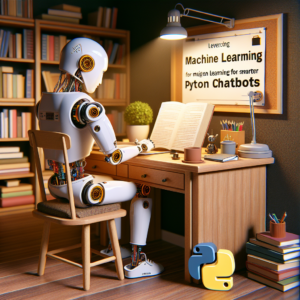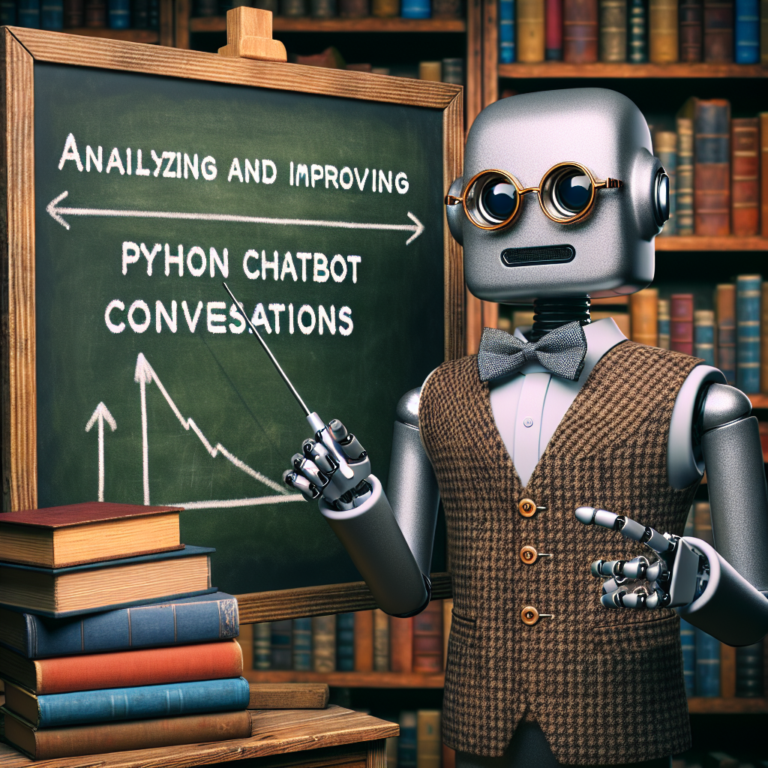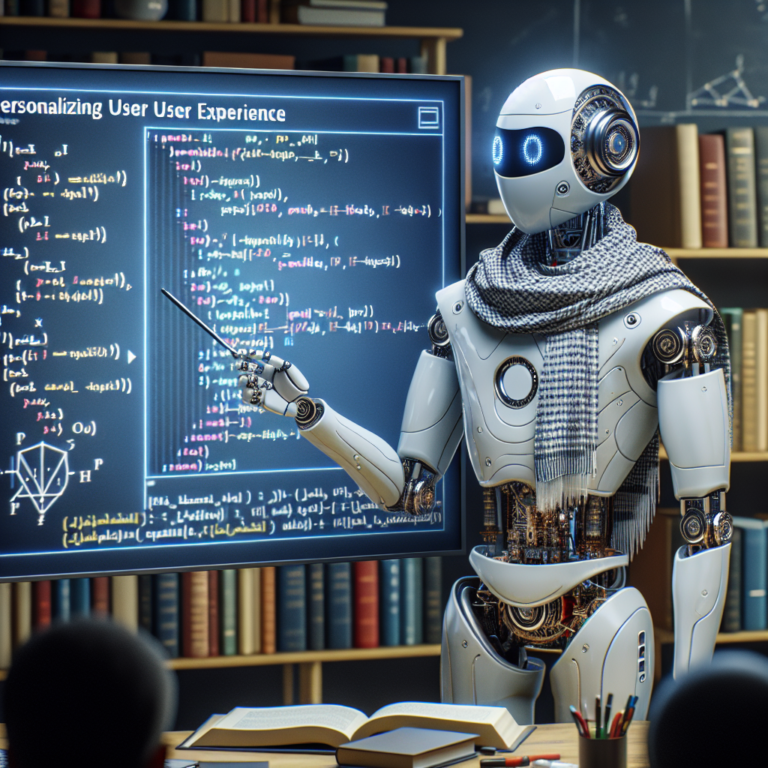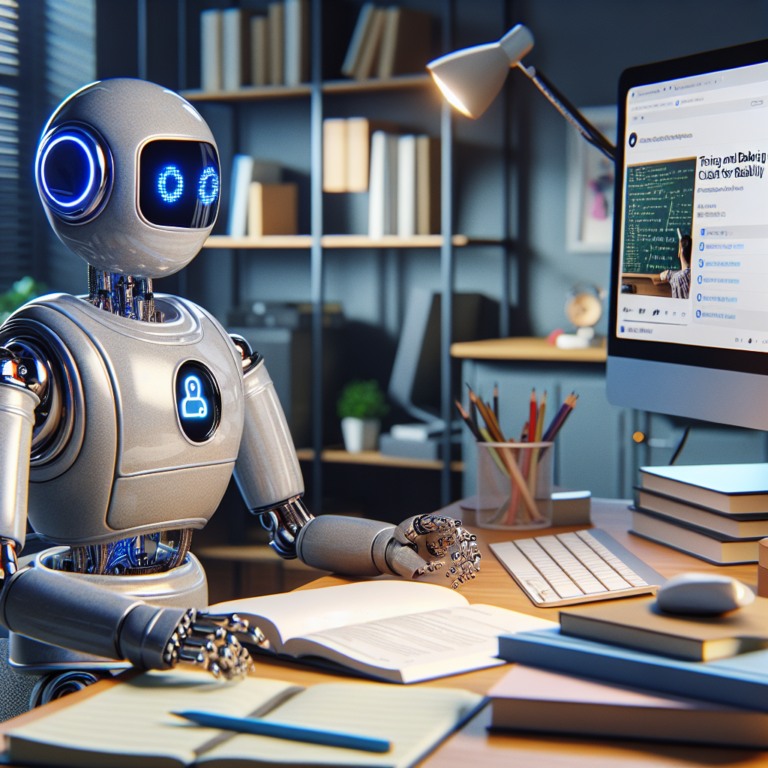1. Exploring the Basics of Machine Learning in Python
Understanding the fundamentals of machine learning is crucial for developing smarter chatbots. This section introduces the core concepts and how they apply to Python, a popular language for machine learning projects due to its simplicity and powerful libraries.
Machine learning involves training algorithms to make predictions or decisions based on data. For Python developers, this starts with choosing the right libraries, such as Scikit-learn for general algorithms, TensorFlow for deep learning, and Pandas for data manipulation.
Here’s a simple example of a machine learning implementation in Python:
from sklearn.datasets import load_iris
from sklearn.tree import DecisionTreeClassifier
# Load the iris dataset
data = load_iris()
X = data.data
y = data.target
# Initialize and train a decision tree classifier
model = DecisionTreeClassifier()
model.fit(X, y)
# Predict the class of a new sample
new_sample = [[5.1, 3.5, 1.4, 0.2]]
prediction = model.predict(new_sample)
print("Predicted class:", prediction)
This code snippet demonstrates loading a dataset, training a decision tree model, and making a prediction. Such foundational skills are essential for integrating machine learning into Python ML integration for chatbots, enhancing their ability to understand and respond to user queries more effectively.
As you progress, you’ll encounter various machine learning models, each suited for different types of data and problem solving. Understanding these models and their application in Python will be key to developing smarter chatbots.
2. Key Machine Learning Algorithms for Chatbot Intelligence
Enhancing smarter chatbots involves leveraging various machine learning algorithms. This section explores key algorithms that significantly boost the intelligence of Python-based chatbots.
Decision Trees are fundamental for classifying user inputs. By mapping out questions and their possible answers, chatbots can more accurately determine the context and intent behind queries.
Naive Bayes classifiers are excellent for text classification, making them ideal for understanding and responding to user messages. They work by applying Bayes’ theorem, with strong (naive) independence assumptions between the features.
Support Vector Machines (SVM) are powerful for text categorization, especially in high-dimensional spaces, which is common in text data. SVMs help in distinguishing between different user intents by creating a hyperplane that maximally separates different categories.
Neural Networks, particularly Recurrent Neural Networks (RNNs) and Long Short-Term Memory networks (LSTMs), are crucial for processing sequences of text. They can remember previous inputs to better understand and generate contextually relevant responses.
from sklearn.feature_extraction.text import TfidfVectorizer
from sklearn.svm import SVC
# Sample data
texts = ["Hello, how can I help you?", "What issue are you facing?", "Please tell me more about your problem."]
labels = [0, 1, 2]
# Text vectorization
vectorizer = TfidfVectorizer()
X = vectorizer.fit_transform(texts)
# Train an SVM classifier
model = SVC()
model.fit(X, labels)
# Example prediction
test_text = vectorizer.transform(["I need assistance with my account."])
prediction = model.predict(test_text)
print("Predicted label:", prediction)
This code snippet demonstrates how to train an SVM to classify different types of customer queries, a common task in chatbot development. By understanding and implementing these algorithms, developers can significantly enhance the capabilities of their Python ML integration in chatbots.
Each algorithm offers unique strengths that, when combined, can provide a robust framework for developing highly responsive and intelligent chatbots.
2.1. Natural Language Processing Techniques
Natural Language Processing (NLP) techniques are pivotal in enhancing the intelligence of smarter chatbots. These techniques allow chatbots to understand and interpret human language, making interactions more seamless and intuitive.
Tokenization is the first step in NLP, where text is broken down into smaller pieces, such as words or phrases. This helps in processing the input more efficiently. Part-of-Speech Tagging follows, which assigns labels to each token (like noun, verb, adjective) to understand their role in the sentence.
Named Entity Recognition (NER) is crucial for identifying and categorizing key information in text, such as names, organizations, locations, and dates. This is particularly useful in chatbot applications for booking tickets, scheduling appointments, or providing personalized recommendations.
Sentiment Analysis allows chatbots to detect the mood or emotional tone behind user inputs, enabling them to respond appropriately. This can significantly enhance user experience by making the chatbot seem more empathetic and responsive.
import nltk from nltk.tokenize import word_tokenize from nltk.tag import pos_tag from nltk.chunk import ne_chunk # Sample text text = "Alice is planning to visit New York City next week." # Tokenization tokens = word_tokenize(text) # POS tagging pos_tags = pos_tag(tokens) # Named Entity Recognition named_entities = ne_chunk(pos_tags) print(named_entities)
This code snippet demonstrates basic NLP tasks using the NLTK library in Python, which is essential for Python ML integration in chatbots. By implementing these techniques, developers can create chatbots that not only understand the literal meaning of user inputs but also grasp the context and subtleties of human language.
Mastering these NLP techniques is a cornerstone for developing smarter chatbots that can interact naturally with users, improving both engagement and satisfaction.
2.2. Implementing Predictive Analytics
Predictive analytics is a cornerstone of machine learning that enhances the functionality of smarter chatbots. By analyzing historical data, chatbots can predict user behavior and provide tailored responses.
Regression Analysis helps in forecasting numerical values, such as estimating waiting times or customer satisfaction levels. This technique is vital for chatbots in service industries where timely and accurate predictions are crucial.
Classification Algorithms like logistic regression are used to categorize user requests into predefined classes. This allows chatbots to handle requests more efficiently by directing them to the appropriate services or responses.
from sklearn.linear_model import LogisticRegression
from sklearn.model_selection import train_test_split
from sklearn.metrics import classification_report
import pandas as pd
# Example dataset
data = {'feature1': [5, 2, 9, 4], 'feature2': [1, 1, 2, 2], 'label': [0, 1, 0, 1]}
df = pd.DataFrame(data)
# Features and target variable
X = df[['feature1', 'feature2']]
y = df['label']
# Splitting the dataset
X_train, X_test, y_train, y_test = train_test_split(X, y, test_size=0.25, random_state=0)
# Logistic regression model
model = LogisticRegression()
model.fit(X_train, y_train)
# Predictions and report
predictions = model.predict(X_test)
print(classification_report(y_test, predictions))
This code snippet demonstrates how to implement logistic regression for classifying user inputs, a common predictive analytics task in Python ML integration for chatbots. By utilizing these predictive techniques, chatbots can anticipate user needs and enhance interaction quality.
Integrating predictive analytics into chatbots not only improves their responsiveness but also personalizes the user experience, making interactions more engaging and efficient.
3. Integrating Machine Learning into Python Chatbots
Integrating machine learning into Python chatbots transforms them into smarter chatbots. This section details the practical steps to achieve this integration effectively.
Firstly, select the appropriate machine learning library. Python offers several options like TensorFlow, PyTorch, and Scikit-learn, each with unique features suitable for different types of machine learning tasks.
Next, prepare your data. Data is the foundation of any machine learning model, and for chatbots, this typically includes large volumes of conversational data. Preprocessing steps like cleaning the data, handling missing values, and tokenization are crucial.
import pandas as pd
from sklearn.model_selection import train_test_split
from sklearn.preprocessing import LabelEncoder
# Load your chatbot data
data = pd.read_csv('chat_data.csv')
data.fillna(method='ffill', inplace=True)
# Encode categorical data
le = LabelEncoder()
data['Tag'] = le.fit_transform(data['Tag'])
# Split data into training and test sets
X_train, X_test, y_train, y_test = train_test_split(data['Text'], data['Tag'], test_size=0.2, random_state=42)
This code snippet shows how to prepare your dataset for training a chatbot model, including handling missing data and splitting the dataset into training and testing sets.
Finally, train your model. Use the processed data to train a machine learning model that can understand and generate human-like responses. After training, integrate this model into your chatbot’s backend. This integration typically involves setting up an API that the chatbot can query to get responses based on the user’s input.
By following these steps, you can enhance your chatbot with Python ML integration, making it not only more responsive but also more intuitive in understanding user needs and preferences.
3.1. Tools and Libraries for ML Integration
Choosing the right tools and libraries is essential for effective Python ML integration in smarter chatbots. This section highlights the most popular and powerful options available.
TensorFlow and Keras are widely used for their flexibility and depth, supporting complex neural network architectures. They are particularly good for developing chatbots that require deep learning to process natural language.
Scikit-learn offers a range of straightforward algorithms for machine learning, which are perfect for beginners and projects that require basic but effective models.
PyTorch is another library known for its ease of use and efficiency in model experimentation, making it a favorite among researchers and developers who need to prototype quickly.
import tensorflow as tf from tensorflow.keras.models import Sequential from tensorflow.keras.layers import Dense, LSTM # Building a simple LSTM model model = Sequential() model.add(LSTM(50, return_sequences=True, input_shape=(1, 50))) model.add(LSTM(50)) model.add(Dense(1)) model.compile(optimizer='adam', loss='mean_squared_error')
This code snippet illustrates setting up a simple LSTM network using TensorFlow and Keras, ideal for processing sequential data like text in chatbot conversations.
Each library has its strengths, and the choice depends on the specific requirements of your chatbot project. TensorFlow and PyTorch are suited for deep learning applications, while Scikit-learn is excellent for simpler, more traditional machine learning models.
Integrating these tools into your chatbot development process can significantly enhance its learning capability and interaction quality, making it more responsive and intelligent.
3.2. Step-by-Step Guide to Building Your ML-Powered Chatbot
Building a smarter chatbot with Python ML integration involves several key steps. This guide will walk you through the process from start to finish.
Step 1: Define the Purpose of Your Chatbot
Identify what you want your chatbot to achieve. Is it for customer service, sales, or something else? This will guide your design and technology choices.
Step 2: Gather and Prepare Your Data
Collect conversational datasets that are relevant to your chatbot’s purpose. Clean the data, which involves removing duplicates, correcting errors, and possibly translating or localizing the content.
import pandas as pd
# Example of loading and cleaning data
data = pd.read_csv('chat_dataset.csv')
data.drop_duplicates(subset='conversation_id', keep='last', inplace=True)
Step 3: Choose a Machine Learning Model
Decide on a model that suits your needs. For a chatbot, models like LSTM (for understanding context in conversations) or BERT (for processing natural language) are common choices.
Step 4: Train Your Model
Use your prepared data to train the model. This involves feeding the data into the model and adjusting parameters to improve accuracy.
from sklearn.model_selection import train_test_split from tensorflow.keras.models import Sequential from tensorflow.keras.layers import LSTM, Dense # Split data X_train, X_test, y_train, y_test = train_test_split(data['text'], data['intent'], test_size=0.2) # Build and train the LSTM model model = Sequential() model.add(LSTM(128, input_shape=(X_train.shape[1], 1))) model.add(Dense(10, activation='softmax')) model.compile(loss='categorical_crossentropy', optimizer='adam', metrics=['accuracy']) model.fit(X_train, y_train, epochs=10)
Step 5: Integrate the Model with Your Chatbot Framework
Once trained, integrate the model into your chatbot’s operating framework so it can use the model’s predictions to interact with users.
Step 6: Test and Refine
Test the chatbot with real users to see how it performs in live interactions. Collect feedback and use it to refine your model and responses.
By following these steps, you can build a machine learning-powered chatbot that is not only effective but also truly enhances user engagement and satisfaction.
4. Real-World Applications of ML-Enhanced Python Chatbots
Machine learning has transformed the capabilities of Python chatbots, making them invaluable across various sectors. This section highlights practical applications where these smarter chatbots are making a significant impact.
In customer service, ML-powered chatbots handle inquiries efficiently, reducing wait times and freeing human agents for complex issues. They use natural language processing to understand and respond to customer needs accurately.
Healthcare sees chatbots providing initial diagnostics and patient support. They analyze symptoms and patient history to offer preliminary advice and schedule appointments, enhancing patient care through timely responses.
E-commerce platforms leverage chatbots for personalized shopping experiences. They recommend products based on user behavior and preferences, significantly boosting user engagement and sales.
Education technology uses chatbots to create interactive learning environments. These bots can tutor students, answer questions, and provide customized feedback, making learning more engaging and accessible.
Here’s an example of how a chatbot can be used in customer support:
from transformers import pipeline
# Initialize a chatbot model
chatbot = pipeline('conversational')
# Example conversation
user_message = "I need help with my order."
response = chatbot(user_message)
print("Chatbot response:", response)
This code snippet demonstrates a simple implementation of a conversational model using the Transformers library, showcasing how easily a chatbot can be integrated into customer support systems.
By integrating machine learning and Python ML integration techniques, chatbots are not only enhancing user experiences but also providing businesses with scalable solutions to manage customer interactions more effectively.
5. Challenges and Solutions in ML Chatbot Development
Developing smarter chatbots through Python ML integration presents unique challenges. This section outlines common issues and their practical solutions.
Challenge 1: Data Scarcity and Quality
High-quality, diverse datasets are crucial for training effective machine learning models. However, acquiring such datasets can be difficult.
Solution: Utilize data augmentation techniques to expand your dataset artificially. Also, consider using pre-trained models that require less data to fine-tune for specific tasks.
Challenge 2: Understanding Context
Chatbots often struggle to grasp the context of a conversation, which can lead to irrelevant responses.
Solution: Implement context-aware algorithms like LSTMs or leverage transformer models like BERT, which are designed to understand context better.
from transformers import BertModel, BertTokenizer
# Example of loading a pre-trained BERT model
tokenizer = BertTokenizer.from_pretrained('bert-base-uncased')
model = BertModel.from_pretrained('bert-base-uncased')
# Encoding text for context understanding
text = "Hello, how can I assist you today?"
encoded_input = tokenizer(text, return_tensors='pt')
output = model(**encoded_input)
Challenge 3: Continuous Learning
Once deployed, chatbots need to continually learn from new interactions to improve.
Solution: Implement online learning protocols where the model can update itself with new data without full retraining.
Challenge 4: User Privacy and Data Security
Handling sensitive user data responsibly is critical, especially when training models that learn from user interactions.
Solution: Ensure compliance with data protection regulations like GDPR. Use anonymization techniques to protect user identities and data.
By addressing these challenges with the outlined solutions, developers can enhance the capabilities of their machine learning-powered chatbots, ensuring they are not only smarter but also more reliable and user-friendly.
6. Future Trends in Machine Learning for Chatbots
The landscape of machine learning in chatbot technology is rapidly evolving. Here, we explore the anticipated trends that will shape the future of smarter chatbots.
Increased Adoption of Transfer Learning: Transfer learning will become more prevalent, allowing chatbots to leverage pre-trained models. This approach reduces the need for extensive data from scratch, enhancing the chatbot’s efficiency and adaptability.
Advancements in Natural Language Understanding (NLU): Future chatbots will exhibit a deeper understanding of context and semantics. This will be driven by improvements in NLU capabilities, enabling chatbots to handle more complex conversations and provide more accurate responses.
Greater Personalization: Machine learning algorithms will increasingly tailor interactions based on user behavior and preferences. This personalization will make chatbots more engaging and effective in user interactions.
Expansion of Multimodal Capabilities: Expect to see chatbots that not only process text but also understand and generate responses based on visual and auditory inputs. This multimodal interaction will make chatbots more versatile and useful across different platforms and use cases.
Ethical AI and Bias Mitigation: As chatbots become more integral to daily interactions, there will be a stronger focus on developing ethical AI practices. This includes efforts to eliminate biases in machine learning models to ensure fairness and inclusivity in chatbot responses.
These trends indicate a shift towards more sophisticated, intuitive, and ethical Python ML integration in chatbots, promising a future where they are not just tools, but essential, trusted companions in digital communication.



